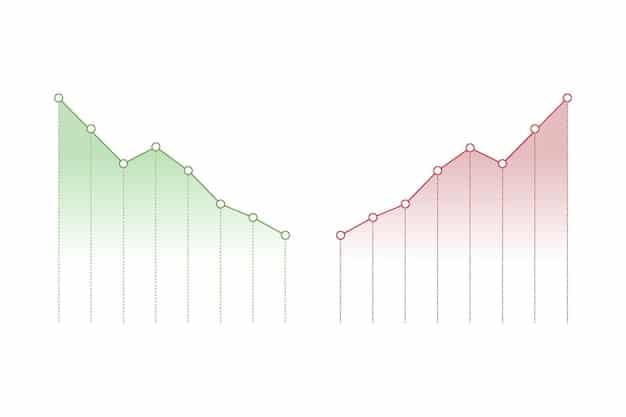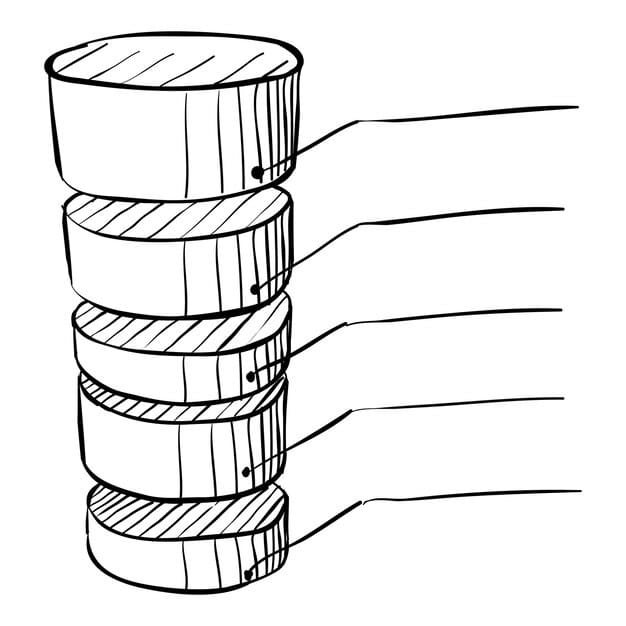Unlock Your Financial Future: Understanding Compound Interest

Compound interest is the interest calculated on the initial principal, which also includes all of the accumulated interest from previous periods on a deposit or loan, potentially leading to significant growth in investments over time.
Are you looking to make your investments work harder for you? Understanding what is compound interest and how it can help you grow your investments is a game-changer for anyone starting their financial journey.
What Is Compound Interest?
At its core, compound interest is interest earned on interest. Unlike simple interest, which is only calculated on the principal amount, compound interest takes into account the principal plus all previously earned interest. This creates a snowball effect, where your money grows at an accelerating rate.
The beauty of compound interest lies in its ability to turn small investments into substantial wealth over time. By reinvesting the earnings, you’re essentially earning interest on your interest, leading to exponential growth.

The Formula Behind the Magic
To understand how compound interest works, it’s helpful to look at the formula:
A = P (1 + r/n)^(nt)
Where:
- A = the future value of the investment/loan, including interest
- P = the principal investment amount (the initial deposit or loan amount)
- r = the annual interest rate (as a decimal)
- n = the number of times that interest is compounded per year
- t = the number of years the money is invested or borrowed for
Let’s break down each component to see how they contribute to the overall growth.
Understanding the Variables
Each variable in the compound interest formula plays a crucial role in determining the final outcome:
- Principal (P): This is the initial amount you invest. A higher principal naturally leads to a larger future value.
- Interest Rate (r): The annual interest rate is the percentage the investment earns each year. Even small differences in interest rates can significantly impact long-term growth due to the compounding effect.
- Compounding Frequency (n): This refers to how often the interest is calculated and added back to the principal each year. The more frequently interest is compounded (e.g., daily vs. annually), the faster the investment grows.
- Time (t): The longer the investment period, the greater the impact of compounding. Time is one of the most powerful factors in growing wealth through compound interest.
In essence, compound interest is a powerful tool for wealth creation, allowing your money to grow exponentially over time.
The Power of Time
Time is arguably the most critical factor in harnessing the full power of compound interest. The longer your money has to grow, the more significant the impact of compounding becomes.
Starting early, even with small amounts, can lead to substantial wealth accumulation over the long term. This is because the early gains have more time to compound, creating a larger base for future growth.
The Early Bird Advantage
Consider two individuals: Sarah, who starts investing $200 per month at age 25, and Tom, who starts investing $400 per month at age 35. Both invest in accounts that earn an average annual return of 7%. Even though Tom invests twice as much each month, Sarah ends up with more money by age 65 due to the earlier start date.
This illustrates the importance of starting early and letting time work its magic. The longer your money is invested, the more opportunities it has to compound and grow exponentially.
Consistency is Key
While starting early is crucial, consistency is equally important. Regularly contributing to your investments, even in small amounts, can significantly boost your long-term returns. Think of it as feeding the compounding engine, keeping it running smoothly and efficiently.
Automating your investments can help ensure consistency. Setting up automatic transfers from your bank account to your investment account each month makes it easier to stay on track and avoid the temptation to skip contributions.
- Start investing as early as possible.
- Be consistent with your contributions.
- Automate your investments to stay on track.
In summary, time is a powerful ally when it comes to compound interest. By starting early and staying consistent, you can maximize the benefits of compounding and achieve your financial goals.
Compound Interest vs. Simple Interest
Understanding the difference between compound interest and simple interest is crucial for making informed investment decisions. While both involve earning interest on a principal amount, the way interest is calculated differs significantly, leading to different outcomes over time.
Simple interest is calculated only on the principal amount, while compound interest is calculated on the principal plus any accumulated interest. This seemingly small difference can have a huge impact on your investment returns, especially over the long term.
Simple Interest Explained
Simple interest is straightforward. The formula for calculating simple interest is:
Simple Interest = P * r * t
Where:
- P = Principal amount
- r = Annual interest rate
- t = Time in years
For example, if you invest $1,000 at a simple interest rate of 5% per year for 10 years, you would earn $500 in interest (1,000 * 0.05 * 10). The interest earned remains constant each year.

Compound Interest: The Exponential Growth Engine
As discussed earlier, compound interest calculates interest on the principal plus accumulated interest. This creates a snowball effect, where your money grows at an accelerating rate.
Consider the same example as above: investing $1,000 at an interest rate of 5% per year for 10 years. With annual compounding, the interest earned in the first year is $50. However, in the second year, you earn interest on $1,050 (the original principal plus the first year’s interest), resulting in a higher interest amount. This process continues each year, leading to exponential growth.
The Long-Term Impact
The difference between simple and compound interest becomes more pronounced over longer periods. While simple interest provides a linear growth, compound interest provides an exponential growth, resulting in significantly higher returns over time.
Here’s a quick comparison:
- Simple Interest: Interest is calculated only on the principal amount. Growth is linear.
- Compound Interest: Interest is calculated on the principal plus accumulated interest. Growth is exponential.
In conclusion, understanding the power of compound interest is essential for making informed investment decisions and achieving long-term financial goals.
Examples of Compound Interest in Action
To truly appreciate the power of compound interest, let’s explore some real-world examples of how it works in action. These examples will illustrate how compounding can benefit you in various financial scenarios.
From savings accounts to retirement funds, compound interest plays a significant role in growing your wealth over time. By understanding how it works, you can make informed decisions and maximize your returns.
Savings Accounts
Many savings accounts offer compound interest, which can help your savings grow faster than simple interest. The more frequently the interest is compounded (e.g., daily or monthly), the more you earn.
For example, if you deposit $5,000 in a savings account with an annual interest rate of 2% compounded daily, you’ll earn slightly more than if the interest were compounded annually. While the difference may seem small, it adds up over time.
Retirement Accounts
Retirement accounts like 401(k)s and IRAs are prime examples of how compound interest can work wonders. These accounts allow your investments to grow tax-deferred, meaning you don’t pay taxes on the earnings until you withdraw them in retirement.
The combination of tax-deferred growth and compound interest can lead to substantial wealth accumulation over the long term. By investing consistently and allowing your investments to compound, you can build a comfortable retirement nest egg.
Debt and Compound Interest
While compound interest can be beneficial for investments, it can also work against you when it comes to debt. Credit cards, for example, often charge high interest rates that compound daily. This can lead to a snowball effect, where your debt grows rapidly if you don’t pay it off promptly.
Understanding how compound interest works on debt can help you make informed decisions and avoid falling into a debt trap. Prioritizing paying off high-interest debt is crucial for maintaining financial health.
- Savings accounts: Earn more with frequent compounding.
- Retirement accounts: Tax-deferred growth amplifies compounding.
- Debt: High interest rates compound against you.
These examples demonstrate the versatility of compound interest and its impact on various financial aspects. Whether you’re saving, investing, or managing debt, understanding compound interest is key to making sound financial decisions.
Strategies to Maximize Compound Interest
Now that you understand what compound interest is and how it works, let’s explore some strategies to maximize its benefits. By implementing these strategies, you can accelerate your wealth accumulation and achieve your financial goals faster.
These strategies focus on optimizing the key variables in the compound interest formula: principal, interest rate, compounding frequency, and time. By making strategic decisions in each of these areas, you can unleash the full potential of compounding.
Increase Your Principal
The larger your principal investment, the more interest you’ll earn. Look for ways to increase your savings and investments, such as:
- Cutting unnecessary expenses
- Increasing your income through side hustles or promotions
- Automating your savings to ensure consistent contributions
Even small increases in your principal can have a significant impact over time due to the compounding effect.
Seek Higher Interest Rates
While interest rates are often beyond your control, you can shop around for accounts that offer higher rates. Consider:
- High-yield savings accounts
- Certificates of Deposit (CDs)
- Bonds
Keep in mind that higher interest rates often come with higher risk, so be sure to do your research and understand the potential downsides before investing.
Optimize Compounding Frequency
The more frequently your interest is compounded, the faster your money will grow. Look for accounts that offer daily or monthly compounding, rather than quarterly or annually.
While the difference may seem small, it can add up over time, especially with larger balances and longer investment horizons.





